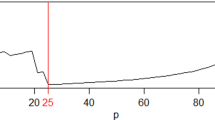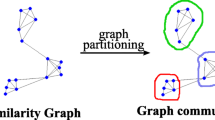Abstract
In an era of massive and complex data, clustering is one of the most important procedures for understanding and analyzing unstructured multivariate data. Classical methods such as K-means and hierarchical clustering, however, are not efficient in grouping data that are high dimensional and have inherent multiscale structures. This paper presents new clustering procedures that can adapt to multiscale characteristics and high dimensionality of data. The proposed methods are based on a novel combination of multiresolution analysis and functional data analysis. As the core of the methodology, a clustering approach using the concept of multiresolution analysis may reflect both the global trend and local activities of data, and functional data analysis handles the high-dimensional data efficiently. Practical algorithms to implement the proposed methods are further discussed. The empirical performance of the proposed methods is evaluated through numerical studies including a simulation study and real data analysis, which demonstrates promising results of the proposed clustering.












Similar content being viewed by others
References
Antoniadis, A., Brossat, X., Cugliari, J., Poggi, J. M. (2013). Clustering functional data using wavelets. International Journal of Wavelets, Multiresolution and Information Processing, 11(01), 1350003.
Chiou, J. M., & Li, P. L. (2007). Functional clustering and identifying substructures of longitudinal data. Journal of the Royal Statistical Society Series B, 69, 679–699.
Floriello, D., & Vitelli, V. (2017). Sparse clustering of functional data. Journal of Multivariate Analysis, 154, 1–18.
Giacofci, M., Lambert–Lacroix, S., Marot, G., Picard, F. (2013). Wavelet–based clustering for mixed–effects functional models in high dimension. Biometrics, 69, 31–40.
Hansen, J., Ruedy, R., Sato, M., Lo, K. (2010). Global surface temperature change. Reviews of Geophysics, 48, RG4004, https://doi.org/10.1029/2010RG000345.
Huang, N. E., & Shen, S. S. P. (2005). Hilbert-Huang transform and its applications. Singapore: World Scientific.
Huang, N. E., Shen, Z., Long, S. R., Wu, M. C., Shih, H. H., Zheng, Q., Yen, N. C., Tung, C. C., Liu, H. H. (1998). The empirical mode decomposition and Hilbert spectrum for nonlinear and nonstationary time series analysis. Proceedings of the Royal Society of London A, 454, 903–995.
Hubert, L., & Arabie, P. (1985). Comparing partitions. Journal of Classification, 2, 193–218.
James, G. M., & Sugar, C. A. (2003). Clustering for sparsely sampled functional data. Journal of the American Statistical Association, 98, 397–408.
Jaques, J., & Preda, C. (2013). Functional data clustering: a survey. Advances in Data Analysis and Classification, 8, 231–255.
Lee, T. C. M. (2004). Improved smoothing spline regression by combining estimates of different smoothness. Statistics & Probability Letters, 67, 133–140.
Mallat, S. (2009). A wavelet tour of signal processing, 3rd. New York: Academic Press.
Morris, J. S., & Carroll, R. J. (2006). Wavelet-based functional mixed models. Journal of the Royal Statistical Society, Series B, 68, 179–199.
Rand, W. M. (1971). Objective criteria for the evaluation of clustering methods. Journal of the American Statistical Association, 66, 846–850.
Ray, S., & Mallick, B. (2006). Functional clustering by Bayesian wavelet methods. Journal of the Royal Statistical Society, Series B, 68, 305–332.
Tibshirani, R., Walther, G., Hastie, T. (2001). Estimating the number of clusters in a data set via the gap statistic. Journal of the Royal Statistical Society, Series B, 63, 411–423.
Wand, M. P. (2000). A comparison of regression spline smoothing procedures. Computational Statistics, 15, 443–462.
Wakefield, J., Zhou, C., Self, S. (2003). Modelling gene expression over time: curve clustering with informative prior distributions. Bayesian Statistics, 7, 721–732.
Witten, D. M., & Tibshirani, R. (2010). A framework for feature selection in clustering. Journal of the American Statistical Association, 105, 713–726.
Acknowledgments
We thank the Editor and referees for comments which led to a substantially improved manuscript. This research was supported by Basic Science Research Program through the National Research Foundation of Korea (NRF) funded by the Korea government (NRF- 2016R1C1B1006572 and NRF-2018R1D1A1B07042933) and by NIH grants (R01HL111195 and R01MH109496).
Author information
Authors and Affiliations
Corresponding author
Additional information
Publisher’s Note
Springer Nature remains neutral with regard to jurisdictional claims in published maps and institutional affiliations.
Rights and permissions
About this article
Cite this article
Lim, Y., Oh, HS. & Cheung, Y.K. Multiscale Clustering for Functional Data. J Classif 36, 368–391 (2019). https://doi.org/10.1007/s00357-019-09313-9
Published:
Issue Date:
DOI: https://doi.org/10.1007/s00357-019-09313-9




